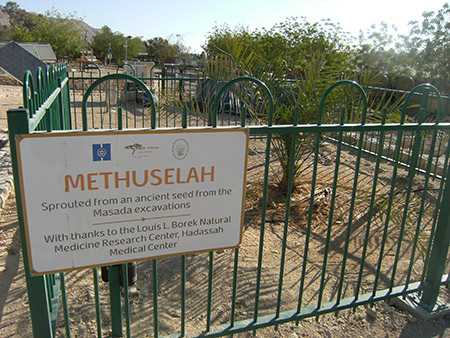This 2,000-Year-Old Palm Tree Produces New Fruit
Could preserving ancient seeds jump-start new life on Planet Earth?
Jurassic Park created excitement with the idea of scientists cloning dinosaurs using DNA from ancient dinosaur bones or eggs. So far, though scientists say they are close, actually bringing back extinct species back to life has proved to be a challenge.
In the plant realm, though, bringing back ancient life is very much science fact, thank you. After uncovering a treasure trove of ancient seeds stored in a clay jar on top of Masada, near the Dead Sea, in Israel in 2005, scientist Elaine Soloway was able to sprout an ancient date palm to life.
Today, the “Methuselah” palm tree stands over ten feet tall. Dr. Soloway was able to pollinate a female tree from Methuselah to produce dates. This tree that has sprouted from an ancient seed has been able to germinate female date trees from a handful of other seeds found there, and would like to cultivate an entire orchard of the ancient trees.

The exercise to bring back ancient seeds is more than one of curiosity, though. The fruit from the tree gives us a better idea about the diet of people in the ancient Middle East. But other questions come out of the experiment: do these fruits have any unique medicinal properties? Might they offer evidence about plant evolution, or changes in the region’s climate?
More, the mere exercise of bringing ancient seeds to life again might be vital to our future. In a large-scale project “to preserve crop diversity for the future,” according to the Norwegian government, the Doomsday Seed Bank has been seeded (pun intended!) to storehouse seeds from up to three million different varieties of plant species, specially wrapped to keep moisture out (and avoid accidental sprouting), in a remote Norwegian island in the Barents Sea near the Arctic Ocean.
Just as Methuselah has been brought back from extinction, perhaps the effort is designed to allow future generations to cultivate food supplies that may no longer exist.
Or perhaps the funders have in mind a “just-in-case” depository to allow future humans to restart our food supply in the event of severe climate change.
Scary thought, or wise planning: what do you think?
Want to Learn More?
- "" , http://www.globalresearch.ca/doomsday-seed-vault-in-the-arctic-2/23503. Accessed on 30 Nov, -0001.
- "" , http://news.nationalgeographic.com/2015/03/150324-ancient-methuselah-date-palm-sprout-science/. Accessed on 30 Nov, -0001.
- "" , https://psmag.com/the-promise-of-ancient-grains-for-future-food-security-1b185872aba2#.kly4m820n. Accessed on 30 Nov, -0001.
- "" , http://www.nytimes.com/video/us/100000002496111/dolly-the-sheep.html. Accessed on 30 Nov, -0001.
- "" , http://www.express.co.uk/news/science/653117/Scientists-closer-to-CLONING-T-Rex-after-discovering-remains-of-pregnant-dinosaur. Accessed on 30 Nov, -0001.